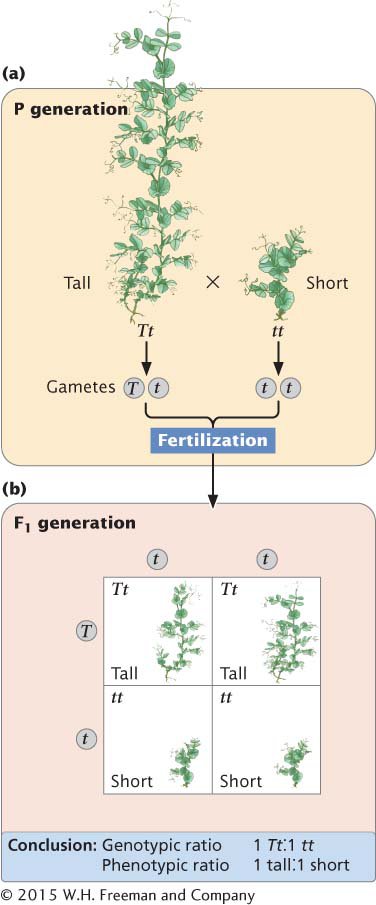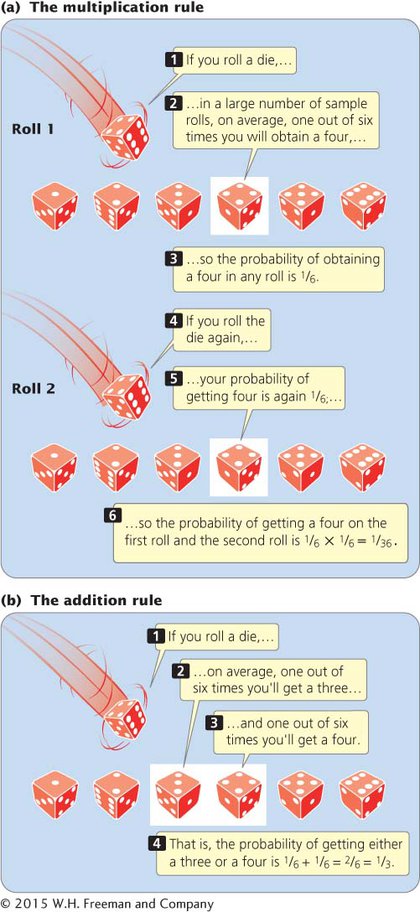Predicting the Outcomes of Genetic Crosses
One of Mendel’s goals in conducting his experiments on pea plants was to develop a way to predict the outcome of crosses between plants with different phenotypes. In this section, you will first learn a simple, shorthand method for predicting the outcomes of genetic crosses (the Punnett square), and you will then learn how to use probability to predict the results of crosses.
THE PUNNETT SQUARE The Punnett square was developed by English geneticist Reginald C. Punnett in 1917. To illustrate the Punnett square, let’s examine another cross carried out by Mendel. By crossing two varieties of peas that differed in height, Mendel established that tall (T) was dominant over short (t). He tested his theory concerning the inheritance of dominant traits by crossing an F1 tall plant that was heterozygous (Tt) with the short homozygous parental variety (tt). This type of cross, between an F1 genotype and either of the parental genotypes, is called a backcross.
To predict the types of offspring that will result from this backcross, we must first determine which gametes will be produced by each parent (Figure 3.6a). The principle of segregation tells us that the two alleles in each parent separate and that one allele passes to each gamete. All gametes from the homozygous tt short plant will receive a single short (t) allele. The tall plant in this cross is heterozygous (Tt), so 50% of its gametes will receive a tall allele (T) and the other 50% will receive a short allele (t).

A Punnett square is constructed by drawing a grid and listing the gametes produced by one parent along the upper edge and the gametes produced by the other parent down the left side (Figure 3.6b). Each cell (that is, each block within the Punnett square) is then filled in with an allele from each of the corresponding gametes, generating the genotype of the progeny produced by fusion of those gametes. In the upper left cell of the Punnett square in Figure 3.6b, a gamete containing T from the tall plant unites with a gamete containing t from the short plant, giving the genotype of the progeny (Tt). It is useful to note the phenotype expressed by each genotype; here, the progeny will be tall because the tall allele is dominant over the short allele. This process is repeated for all the cells in the Punnett square.
By simply counting, we can determine the types of progeny produced and their ratios. In Figure 3.6b, two cells contain tall (Tt) progeny and two cells contain short (tt) progeny; so the genotypic ratio expected for this cross is 2 Tt to 2 tt (a 1:1 ratio). Another way to express this result is to say that we expect ½ of the progeny to have genotype Tt (and the tall phenotype) and ½ of the progeny to have genotype tt (and the short phenotype). In this cross, the genotypic ratio and the phenotypic ratio are the same, but this outcome need not be the case. Try completing a Punnett square for the cross in which the F1 round-
52
CONCEPTS
The Punnett square is a shorthand method of predicting the genotypic and phenotypic ratios of progeny from a genetic cross.
 CONCEPT CHECK 4
CONCEPT CHECK 4
If the F1 plant depicted in Figure 3.4 is backcrossed to the parent with round seeds, what proportion of the progeny will have wrinkled seeds? (Use a Punnett square.)
¾
½
¼
0
d
PROBABILITY AS A TOOL IN GENETICS Another method for determining the outcome of a genetic cross is to use the rules of probability, as Mendel did with his crosses. Probability expresses the likelihood of the occurrence of a particular event. It is the number of times that a particular event takes place, divided by the number of all possible outcomes. For example, a deck of 52 cards contains only one king of hearts. The probability of drawing one card from the deck at random and obtaining the king of hearts is 1/52 because there is only one card that is the king of hearts (one event) and there are 52 cards that can be drawn from the deck (52 possible outcomes). The probability of drawing a card and obtaining an ace is 4/52 because there are four cards that are aces (four events) and 52 cards (possible outcomes). Probability can be expressed either as a fraction (4/52 in this case) or as a decimal number (0.077 in this case).
The probability of a particular event may be determined by knowing something about how or how often the event takes place. We know, for example, that the probability of rolling a six-
THE MULTIPLICATION RULE Two rules of probability are useful for predicting the ratios of offspring produced in genetic crosses. The first is the multiplication rule, which states that the probability of two or more independent events taking place together is calculated by multiplying their independent probabilities.
To illustrate the use of the multiplication rule, let’s again consider the roll of a die. The probability of rolling one die and obtaining a four is ⅙. To calculate the probability of rolling a die twice and obtaining two fours, we can apply the multiplication rule. The probability of obtaining a four on the first roll is ⅙ and the probability of obtaining a four on the second roll is ⅙; so the probability of rolling a four on both is ⅙ × ⅙ = 1/36 (Figure 3.7a). The key indicator for applying the multiplication rule is the word and; in the example just considered, we wanted to know the probability of obtaining a four on the first roll and a four on the second roll.

For the multiplication rule to be valid, the events whose joint probability is being calculated must be independent—
THE ADDITION RULE The second rule of probability frequently used in genetics is the addition rule, which states that the probability of any one of two or more mutually exclusive events is calculated by adding the probabilities of these events. Let’s look at this rule in concrete terms. To obtain the probability of throwing a die once and rolling either a three or a four, we would use the addition rule, adding the probability of obtaining a three (⅙) to the probability of obtaining a four (again, ⅙), or ⅙ + ⅙ = 2/6 = ⅓ (Figure 3.7b). The key indicators for applying the addition rule are the words either and or.
53
For the addition rule to be valid, the events whose probability is being calculated must be mutually exclusive, meaning that one event excludes the possibility of the occurrence of the other event. For example, you cannot throw a single die just once and obtain both a three and a four, because only one side of the die can be on top. These events are mutually exclusive.
CONCEPTS
The multiplication rule states that the probability of two or more independent events taking place together is calculated by multiplying their independent probabilities. The addition rule states that the probability that any one of two or more mutually exclusive events taking place is calculated by adding their probabilities.
 CONCEPT CHECK 5
CONCEPT CHECK 5
If the probability of being blood type A is ⅛ and the probability of being blood type O is ½, what is the probability of being either blood type A or blood type O?
⅝
½
1/10
1/16
a
APPLYING PROBABILITY TO GENETIC CROSSES The multiplication and addition rules of probability can be used in place of the Punnett square to predict the ratios of progeny expected from a genetic cross. Let’s first consider a cross between two pea plants heterozygous for the locus that determines height, Tt × Tt. Half of the gametes produced by each plant have a T allele, and the other half have a t allele, so the probability for each type of gamete is ½.
The gametes from the two parents can combine in four different ways to produce offspring. Using the multiplication rule, we can determine the probability of each possible type. To calculate the probability of obtaining TT progeny, for example, we multiply the probability of receiving a T allele from the first parent (½) times the probability of receiving a T allele from the second parent (½). The multiplication rule should be used here because we need the probability of receiving a T allele from the first parent and a T allele from the second parent—
| TT | (T gamete and T gamete) ½ × ½ = ¼ | tall |
| Tt | (T gamete and t gamete) ½ × ½ = ¼ | tall |
| tT | (t gamete and T gamete) ½ × ½ = ¼ | tall |
| tt | (t gamete and t gamete) ½ × ½ = ¼ | short |
Notice that there are two ways for heterozygous progeny to be produced: a heterozygote can either receive a T allele from the first parent and a t allele from the second or receive a t allele from the first parent and a T allele from the second.
After determining the probabilities of obtaining each type of progeny, we can use the addition rule to determine the overall phenotypic ratios. We use the addition rule because we want to know the probability that an individual pea plant is genotype TT, Tt, or tT, any of which produce a tall plant. These events are mutually exclusive because an individual can have only one genotype at this locus. Using the addition rule, we find the probability of tall progeny to be ¼ + ¼ + ¼ = ¾. Because only one genotype encodes short (tt), the probability of short progeny is simply ¼.
54
Two methods have now been introduced to predict the results of genetic crosses: the Punnett square and the probability method. At this point, you may be asking, “Why bother with probability rules and calculations? The Punnett square is easier to understand and just as quick.” This is true for simple monohybrid crosses. For tackling more complex crosses involving genes at two or more loci, however, the probability method is both clearer and quicker than the Punnett square.
CONDITIONAL PROBABILITY Thus far, we have used probability to predict the chances of producing certain types of progeny given only the genotypes of the parents. Sometimes we have additional information that modifies, or “conditions,” the probability, a situation termed conditional probability. For example, assume that we cross two heterozygous pea plants (Tt × Tt) and obtain a tall offspring plant. What is the probability that this tall plant is heterozygous (Tt)? You might assume that the probability would be ½, the probability of obtaining a heterozygous offspring in a cross between two heterozygotes. In this case, however, we have some additional information— TRY PROBLEMS 24 AND 25.
TRY PROBLEMS 24 AND 25.